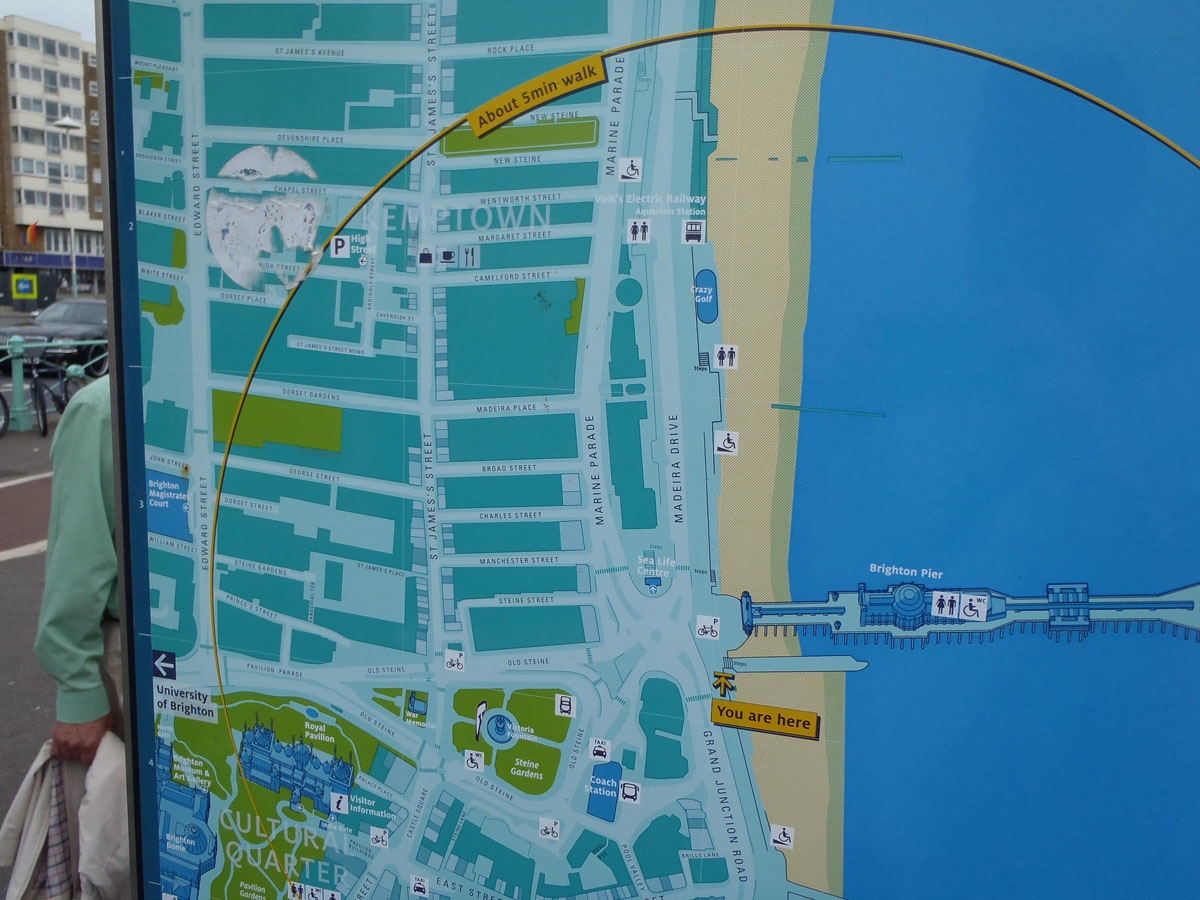This is the second in a series of posts on innovative bicycle infrastructure tools used in England. The subject of this post is bicycle route signage that uses estimated travel time rather than mileage to destinations. Below is an example of one sign on the Beach front path in Brighton, England.
Instead of telling cyclists that they have 5 or 10 miles to their destination, these signs tell cyclists that it will take them approximately 2 minutes or 9 minutes or 15 minutes to reach their destination. The times are usually based on a speed of 10 miles per hour so a cyclists going from Downtown to Cheesman Park, a distance of approximately 2 miles, would see a sign telling them that Cheesman Park is 12 minutes away. This form of signage has several advantages over the milage signs currently used in Denver.
First and most importantly they dispel the myth that bicycling is slow. Approximately 40% of daily trips are less than 2 miles in length. So cyclists and, perhaps more importantly potential cyclists, who see the time-to-destination-based signs will realize that they can get to most of the places they need to go in less than 15 minutes by bicycle. This will encourage more people to try bicycles for short trips.
Second, in actuality, most cyclists travel faster than the 10 miles per hour on which the signs calculations are based. Thus, when actually taking the trips, many people will find that they arrive at their destination even sooner than the signs indicated. This has a positive mental impact on people who may conclude that bicycling is even faster and easier than they expected.
Brighton also uses similar signs for transit stops and walking signs. See the examples below.
These time-based signs show just how easy and convenient it can be to take a bike, transit or simply walk to a destination. I find that bicycling Downtown from my home in Five Points is almost always faster than taking a car. The time spent parking and walking to destinations adds substantially to automobile trips. The time-based signs make the ease of using transit, walking and bicycling clear, and may encourage more people to give these modes a try.













OMG. Simple, obvious and elegant. Also timely since Denver is in the middle of upgrading its paths & signage. I’ve forwarded this post to a couple of email addresses I found related to Denver Moves and to my councilman. Hopefully something will come of it 🙂
The southwest area of Portland, Oregon has signs like these that denote the time and mileage to important points of interest in the area.
The reason why bicycling is so much faster than driving is because we don’t have to stop at red lights or stopsigns! You would be amazed how much time car commuters spend obeying the traffic laws.
Actually, cyclists ARE required to stop at redlights and stopsigns according to the Colorado Statutes:
TITLE 42 VEHICLES AND TRAFFIC : REGULATION OF VEHICLES AND TRAFFIC : ARTICLE 4 REGULATION OF VEHICLES AND TRAFFIC : PART 14 OTHER OFFENSES : 42-4-1412. Operation of bicycles and other human-powered vehicles.
(1) Every person riding a bicycle shall have all of the rights and duties applicable to the driver of any other vehicle under this article, except as to special regulations in this article and except as to those provisions which by their nature can have no application. Said riders shall comply with the rules set forth in this section and section 42-4-221, and, when using streets and highways within incorporated cities and towns, shall be subject to local ordinances regulating the operation of bicycles as provided in section 42-4-111.
and per Denver Municipal Code:
Sec. 54-567. – Obedience to traffic-control devices.
(a)
Any person operating a bicycle or electrical assisted bicycle, shall obey the instructions of official traffic-control signals, signs and other control devices applicable to vehicles, unless otherwise directed by a police officer.
(b)
Whenever authorized signs are erected indicating that no right or left or U-turn is permitted, it shall be unlawful for any person operating a bicycle or electrical assisted bicycle to disobey the direction of any such sign, except where such person dismounts from the bicycle or electrical assisted bicycle to make any such turn, in which event, such person shall then obey the regulations applicable to pedestrians.
(Code 1950, § 522.12; Ord. No. 685-09, § 9, 11-23-09)
I know my commute would be a lot faster if I failed to obey the law as well.
Having lived in Europe twice for a total of 5 years, these types of signs are a happy harbinger for change here in Colorado.
Also I like the idea of presumptive close – walking and biking times are given, but none for cars!